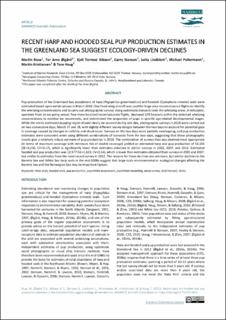| dc.description.abstract | Pup production of the Greenland Sea populations of harp (Pagophilus groenlandicus) and hooded (Cystophora cristata) seals were estimated based upon aerial surveys in March 2018. One fixed-wing aircraft was used for large-area reconnaissance flights to identify the whelping concentrations and to carry out photographic surveys along systematic transects over the whelping areas. A helicopter, operated from an ice-going vessel, flew more localised reconnaissance flights, deployed GPS beacons within the detected whelping concentrations to monitor ice movements, and determined the proportion of pups in specific age-related developmental stages. While the entire estimated pupping region should ideally be covered during one day, photographic surveys in 2018 were carried out on two consecutive days, March 27 and 28, with slightly different survey designs between the two days to account for potential gaps in coverage caused by changes in visibility and cloud cover. Surveys on the two days were partially overlapping, and pup production estimates were consistent when using different combinations of transects from the two days, suggesting that these photographic counts give a relatively robust estimate of pup production in 2018. The combination of surveys that was deemed most appropriate (in terms of maximum coverage with minimum risk of double coverage) yielded an estimated harp seal pup production of 54,181 (SE=9,236, CV=0.17), which is significantly lower than estimates obtained in similar surveys in 2002, 2007, and 2012. Estimated hooded seal pup production was 12,977 (SE=1,823, CV=0.14), which is lower than estimates obtained from surveys in 2005 and 2007, but similar to estimates from the most recent survey in 2012. The reasons for these declines are unknown, but similar declines in theBarents Sea and White Sea harp seals in the mid-2000s suggest that large-scale environmental or ecological changes affecting the Barents Sea and the Norwegian Sea may be important factors. | |
